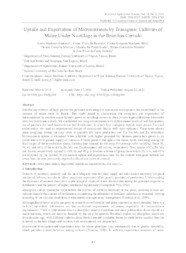Uptake and exportation of micronutrients by transgenic cultivars of maize under no-tillage in the Brazilian Cerrado.
Uptake and exportation of micronutrients by transgenic cultivars of maize under no-tillage in the Brazilian Cerrado.
Autoria: GUTIÉRREZ, A. M.; RESENDE, A. V. de; SILVA, K. G. M.; MARTINS, D. C.; SIMÃO, E. de P.; MOREIRA, S. G.; FERREIRA, J. P. da C.
Resumo: Introducing cultivars of high productive potential with adequate agronomic management has contributed to the increase of maize yield in Brazil. This study aimed to characterize the extraction and exportation of micronutrients by modern maize hybrids grown in no-tillage system in the Cerrado region (Brazilian Savannah) with two fertilization levels. We established two crop environments with differentiated levels of soil fertilization, use of products for seed treatment and leaf fertilization, in which four transgenic hybrids were grown. For each environment, we used an experimental design of randomized blocks with four replicates. There were eleven plant samplings during the crop cycle to quantify dry mass production and Cu, Fe, Mn and Zn extraction. Micronutrient uptake is increased when a hybrid with higher potential for biomass production grows in an environment with greater supply of nutrients. Uptake persists throughout the maize cycle, including during the final stages of the reproductive phase, showing late demand for the crop. On average, after tasseling, about 39, 50, 42, and 49% of the total Cu, Fe, Mn and Zn absorption still occurs, respectively. Total uptake of Cu, Fe, Mn and Zn are, respectively, around 8, 199, 58 and 40 g to produce a tonne of grain, from which 23, 5, 8, and 42% are exported by the harvest. Micronutrient uptake and exportation rates for the studied transgenic hybrids are lower than the ones previously reported in Brazil and in works abroad. Keywords
Ano de publicação: 2018
Tipo de publicação: Artigo de periódico
Unidade: Embrapa Milho e Sorgo
Palavras-chave: Absorção, Exigência Nutricional, Rendimento, Zea Mays
Observações
1 - Por padrão são exibidas publicações dos últimos 20 anos. Para encontrar publicações mais antigas, configure o filtro ano de publicação, colocando o ano a partir do qual você deseja encontrar publicações. O filtro está na coluna da esquerda na busca acima.
2 - Para ler algumas publicações da Embrapa (apenas as que estão em formato ePub), é necessário ter, no celular ou computador, um desses softwares gratuitos. Sistemas Android: Google Play Livros; IOS: iBooks; Windows e Linux: software Calibre.
Acesse outras publicações
Acesse a Base de Dados da Pesquisa Agropecuária (BDPA) para consultar o acervo completo das bibliotecas da Embrapa.

